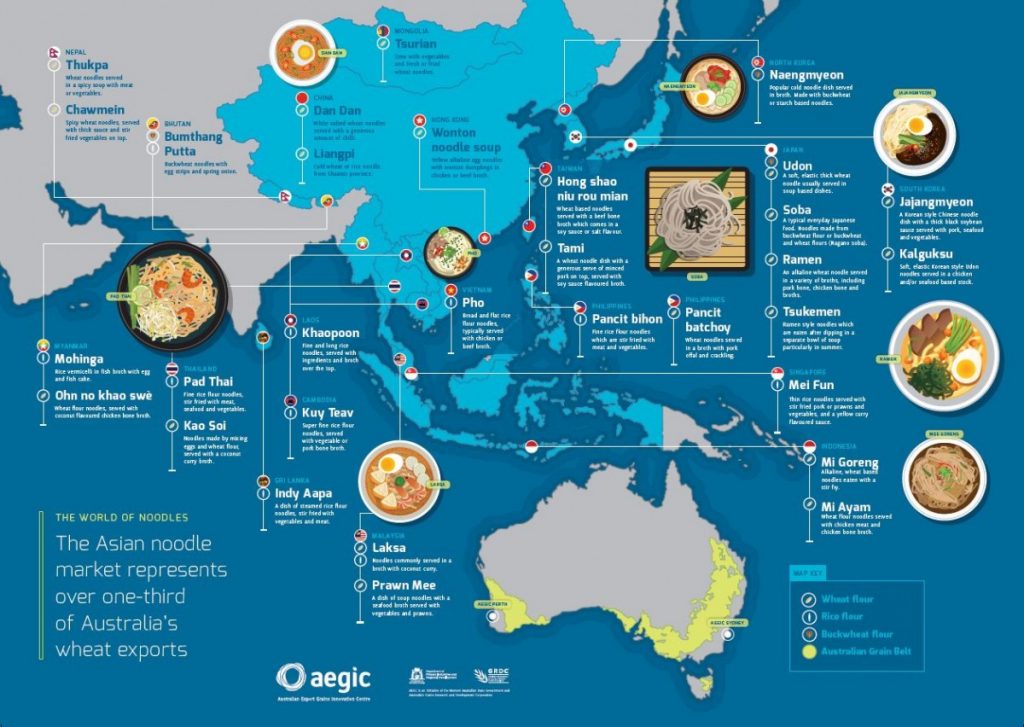The noodle is an important food in both the Italian and Chinese culture. Just as specific types of pasta can be the cultural identity for cities in the Italian culture, the different types of Chinese noodle also reflect the emotions, beliefs and values of the people who cook them.
Pasta is one of the most important and representative foods in the Italian culture. As Massimo Montanari mentioned in his book Let the Meatballs Rest: And Other Stories About Food and Culture, “Pasta means Italy. No other food identifies more effectively the many parts of Italian gastronomy and, in a way, unites them.” (Montanari, Let the Meatballs Rest: And Other Stories About Food and Culture, 159) Montanari asserts that pasta can be viewed as a metaphor for both unity and variety in Italian food culture. Although pasta is a single type of food that can serve as the cultural identity for Italy, pasta is also divided into a large number of varieties, each of them unique in their shape, cooking methods, sauces, and purposes. Therefore, for the cultural identity for Italy, pasta can represent both unity and differences, which is important for Italy, a country which had a long history of being divided into different parts, but were eventually united together into one country. Although Italy is one single country now, many of its regions have different cultures and traditions, similar to the fact the each region has their unique style of making pasta.
The cultural identity of China can also be found in the noodles, considering their interesting styles, meanings and background stories. Food plays a significant role in the Chinese culture, and among the numerous categories of Chinese foods, the noodle is one of the most representative of the Chinese traditional values, beliefs and cultures. Chinese people eat different kinds of noodles at different occasions, seasons and festivals. For example, it is the Chinese custom to eat the longevity noodles during birthdays, noodles with gravy when moving into a new house or at the time of a marriage, and dragon whisker noodles on the day of lunar February 2. There are also noodles with interesting stories associated with them, such as the dutiful son’s noodle, dan dan noodles, sister-in-law noodles and old friend noodles. (Zhang, Noodles: Traditional and Today, 210) These noodles reflected the love, dreams, care and friendship of the people who cooked the noodles. Therefore, each of these noodles is not only unique in cooking style and tastes, but is also special in its meanings and representations of the emotions of the people who cooked them.
One of the most famous types of noodles is the Crossing-the-Bridge noodles, which is a rice noodle soup from the Yunnan Province. Crossing-the-Bridge noodles also has an interesting story associated with it. According to the story, the noodle was invented to have the capability of keeping warm for a long time under cold winds and temperatures, so that when the cook brings the noodle soup across the bridge to the boy who was studying for the imperial examinations, the noodle soup would still be hot and warm enough to eat. “ ‘It is too hot!’ he said, and began laughing. ‘I know,’ said the cook, nodding happily. ‘It is the fat that keeps out the wind, the cold, and the bad spirits. Now that you have the nourishment you need, learning will come naturally and gracefully.’ The boy ate the delicious soup with a hunger that he did not know he had as he watched the chef skipping like a child across the bridge back to his kitchen.” (Durack, Noodle, 183) Therefore, Crossing-the-Bridge noodles reflected the cleverness and mastery of the cook in cooking, as well as the love and care he had for the boy, and the passion he had for pleasing people with his food. The interesting background stories of the various types of noodles also reflected the important traditional Chinese values of filial piety, family relations, friendship, and care for others.
If I were to create a definition of the noodle based on what I have learned about the noodle as seen in Italy and China, which is also my own country of origin, I would add to the clinical definition of the noodle, which is “a food paste made usually with egg and shaped typically in ribbon form,” according to Merriam Webster, by defining noodle as “a food paste made usually with egg or wheat and shaped in various forms according to the traditional culture of the region, originating from China and Italy, and would often reflect the histories, values, and beliefs of the culture, region, cities, and people who cook it.”

Image Source: https://www.aegic.org.au/the-world-of-noodles/
Works Cited
Durack, Terry. “Crossing the Bridge.” Noodle, Pavilion, 2001, pp. 182–183.
Montanari, Massimo. Let the Meatballs Rest: and Other Stories about Food and Culture. Columbia University Press, 2015, pp. 156–163.
“Noodle.” Merriam-Webster, Merriam-Webster, www.merriam-webster.com/dictionary/noodle.
Zhang, Na, and Guansheng Ma. “Noodles, Traditionally and Today.” Journal of Ethnic Foods, vol. 3, no. 3, 2016, pp. 209–212., doi:10.1016/j.jef.2016.08.003.
